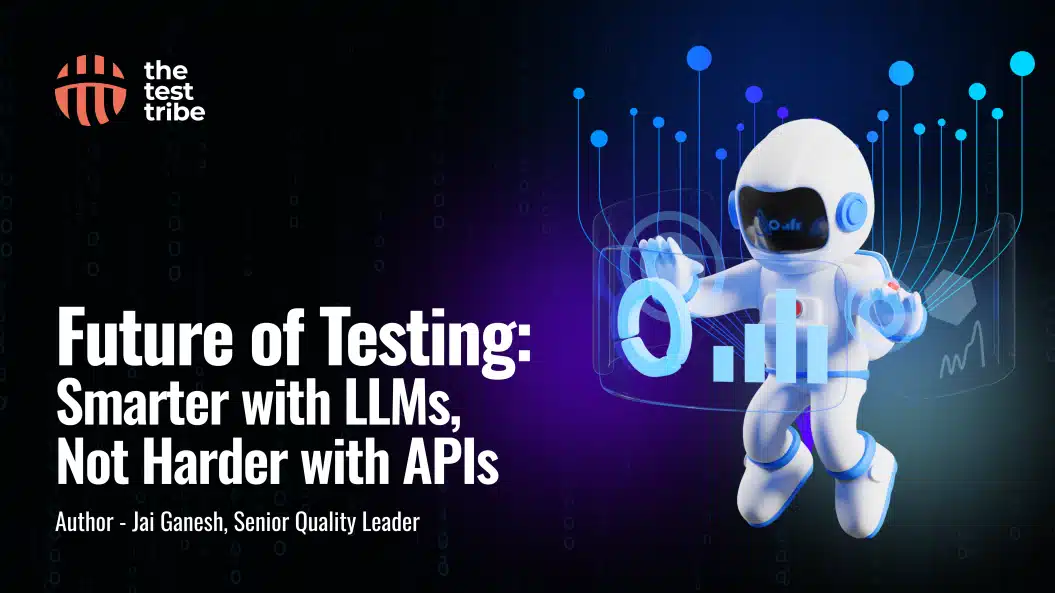I have been a tester for many years and have witnessed ‘n’ number of the so called testing revolutions! But I understand LLMs are here to stay and will make the testing industry more efficient.
Now, What is API Testing and Why is it needed especially now?
APIs enable communication between two software components using a set of definitions and protocols. API testing is designed to assess the functionality, reliability, performance, and security of an API, and is, therefore, an essential part of the software development lifecycle. Understanding why we do API testing is crucial in the context of evolving technologies. API testing is important for ensuring that a given API performs as expected when faced with a wide variety of actual and unexpected requests. Implementing an automated testing strategy can enhance the efficiency and coverage of API testing. This process is designed to test the API’s functionality, reliability, performance, and security. Given that we are at the brink of the need to build and scale fast environments many companies are adapting to a strategic shift left testing to cover their bases and then cover some level of frontend check for user experience but at least the functionalities are covered and the team can be reliable. This demonstrates why DevOps recommends shift-left testing principles in modern development.
And what is an LLM?
Foundation models, large in size, are trained using large amounts of data. This means that they can understand natural language and create other forms of text that can be used to perform many tasks. These models are intended to understand the text and generate it similarly to a human, as well as other content types because they learn from such large datasets during training— they produce contextually coherent responses, translate languages outside English, summarize text, or answer questions among many others. They accomplish this through their billions of parameters which allow them not only to grasp complex patterns within language but also provide an extensive range of services related to language itself. Applications based on LLMs have been described as revolutionary; these include chatbots and virtual assistants up to research support or even creative writing for code development systems due entirely to LLM capabilities in all those areas without any manual intervention.
Improving the efficiency of API Automation Testing by LLM.
With their capabilities to sift through large volumes of data and forecast probable glitches, these technologies can make AI more like an inspector— not just of application functionality tests, but also of patterns that may lead to issues. The move away from waiting for issues to arise during testing would mean that many APIs are being made secure and robust right from their inception.
LLMs — proficient in both human language and code — have the potential to be priceless partners when it comes to designing tests. They are able to convert explanations of what is expected from an API into detailed test cases; thus, they can make this process available to all individuals by sharing knowledge on it and empower non-technical stakeholders who could play a role in API quality. At the same time, they are capable of evolving as living test partners: they imbibe knowledge from every test that takes place and fine-tune their strategies as a result.
However, the AI adoption faces challenges, such as biases in training data, the “black box” nature of some AI models, and ethical considerations. These issues add to the existing software testing challenges in AI integration. Far from it; AI and LLM in API testing is a reality we have to contend with. By taking note of their limits and having verification measures, we can move into an era of APIs evolving where data will flow effortlessly through our digital orchestras.
So, how do we go about it?
Test Case Designing in Software Testing
QA engineers create test cases for each software requirement after defining the scope and preparing the test environment and API automation. Employing advanced test case design strategies in software testing enhances the quality and coverage of these test cases. These test cases must include both positive and negative aspects, demonstrating the software’s thorough testing and expected behaviour. The test case should be well thought and the document should be detailed, including the test case ID, test description, testing conditions, assumptions and preconditions, testing steps, input test data, expected results, actual and postcondition results, and pass/fail status.
Simplifying Test Case Generation Using LLM
Creating test case documentation is not an easy task. Solutions must be smart enough to adapt test cases to different applications and functions. Current technologies include machine learning to learn application paths, code automation analysis to create test cases, and tracking user paths to identify tasks. These approaches face the following challenges: Comprehensive data analysis and adaptability to different applications are required.
Automated test cases can be rigid (unit tests that must pass before each release) or fluid (test cases that inform developers about user experience). Generating test cases must be sophisticated enough to meet the needs of each development team. Although the research is still in its infancy, it is promising. You can use Devzery’s Testcase generator(https://www.devzery.com/open-source) they have recently open-sourced its AI-driven API for generating test cases, reducing the manual work of documentation.
Test Case Execution Strategy
In the current fast-moving world, ensuring software quality is no longer a separate phase, but it’s a continuous process, a key component of the Software Development Lifecycle (SDLC).
Therefore, we need to strategically plan the execution of test cases and then automate them with priority and severity in mind. This ensures that the development team performs continuous testing, which is the cornerstone of Agile and DevOps methodologies, improving test coverage and efficiency, leading to earlier defect detection and faster bug fixes.
Test Case Automation
Analysed test cases can now be prioritized for scripting. Some tools can help you write scripts! Integrate them into your CICD pipeline to ensure overall application reliability and keep a close eye on failure scenarios.
Conclusion
The fusion of LLM and AI inevitably will transform traditional approaches into efficient, proactive, and dynamic processes. By leveraging these technologies, we can achieve higher accuracy, better performance, and a more reliable software development lifecycle. We would become the strategic test designers in the future!





